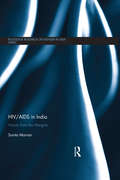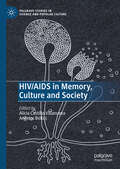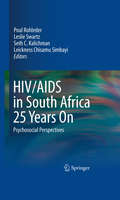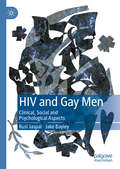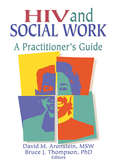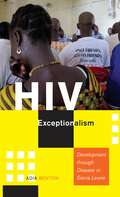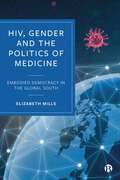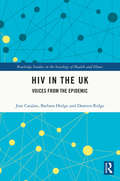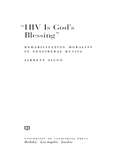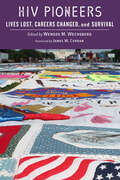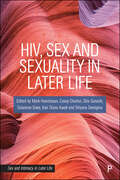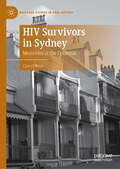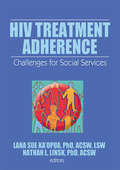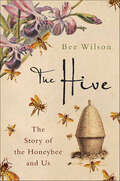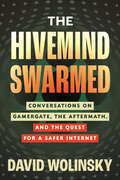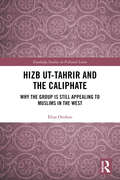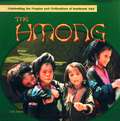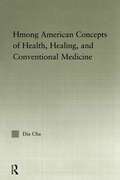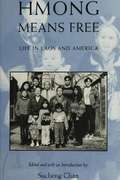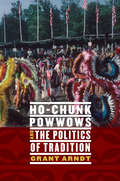- Table View
- List View
HIV/AIDS in India: Voices from the Margins (Routledge Research on Gender in Asia Series)
by Sunita ManianIndia ranks third in the number of people living with HIV/AIDS globally. The country has high levels of poverty and inequality, poor healthcare infrastructure, especially away from the metropolitan areas, and a legacy of colonialism that bequeathed laws criminalizing non-heteronormative sexualities. These factors mean that many minority groups do not receive adequate access to preventative and treatment programs. This book explores the HIV/AIDS epidemic in India. Based on research in Tamil Nadu, it presents experiences of those marginalized by their sexuality and/ or gender, their struggles and their triumphs. Based on interviews with male and female sex-workers, men who have sex with men, aravanis (male to female transgenders) and HIV positive women—groups usually not included in the policy-making by Indian government agencies, international donors and international NGOs—the author uses an interdisciplinary approach. The approach highlights the historical and cultural context, while providing contemporary narratives. The book thus presents a deeper, multi-dimensional, understanding of the context of the disease and comprehends the roots of the stigma and discrimination that exacerbate the epidemic. An important study of the global HIV/AIDS epidemic, this book will be of interest to researchers in the field of South Asian Studies, Sexuality and Gender Studies, Health Sciences and Public Health.
HIV/AIDS in Memory, Culture and Society (Palgrave Studies in Science and Popular Culture)
by Alicia Castillo Villanueva Angelos BollasThis volume examines the role of culture in developing social, cultural and political discourses of HIV/AIDS from a contemporary viewpoint. In doing so, the memory of HIV/AIDS is a powerful tool to examine representations of the past and connect them with future debates. This reassessment of HIV/AIDS explores the most appropriate way to come to terms with a past that involved a negative, stigmatised and marginalised representation. Therefore, remembering plays a key role in generating collective memory, which allows for the exchange of mnemonic content between individual minds, creates discourses on memory and commemoration, and disseminates versions of the past that may affect the representation of HIV/AIDS in the future. Indeed, rewriting about the past also means assessing our responsibility towards the present and the potential of transmission to future generations, especially in times of pandemics.
HIV/AIDS in South Africa 25 Years On
by Seth C. Kalichman Poul Rohleder E. Cameron Leslie Swartz Leickness Chisamu SimbayiMuch has happened since the first appearance of AIDS in 1981: it has been identified, studied, and occasionally denied. The virus has shifted host populations and spread globally. Medicine, the social sciences, and world governments have joined forces to combat and prevent the disease. And South Africa has emerged as ground zero for the pandemic. The editors of HIV/AIDS in South Africa 25 Years On present the South African crisis as a template for addressing the myriad issues surrounding the epidemic worldwide, as the book brings together a widely scattered body of literature, analyzes psychosocial and sexual aspects contributing to HIV transmission and prevention, and delves into complex intersections of race, gender, class, and politics. Including largely overlooked populations and issues (e.g., prisoners, persons with disabilities, stigma), as well as challenges shaping future research and policy, the contributors approach their topics with rare depth, meticulous research, carefully drawn conclusions, and profound compassion. Among the topics covered: The relationship between HIV and poverty, starting from the question, "Which is the determinant and which is the consequence?"Epidemiology of HIV among women and men: concepts of femininity and masculinity, and gender inequities as they affect HIV risk; gender-specific prevention and intervention strategies. The impact of AIDS on infants and young children: risk and protective factors; care of children by HIV-positive mothers; HIV-infected children.Current prevention and treatment projects, including local-level responses, community-based work, and VCT (voluntary counseling and testing) programs.New directions: promoting circumcision, vaccine trials, "positive prevention."South Africa's history of AIDS denialism.The urgent lessons in this book apply both globally and locally, making HIV/AIDS in South Africa 25 Years On uniquely instructive and useful for professionals working in HIV/AIDS and global public health.
HIV and Gay Men: Clinical, Social and Psychological Aspects
by Rusi Jaspal Jake BayleyThis book focuses on the clinical, social and psychological aspects of HIV among gay men and examines the complex factors that can contribute to HIV risk in this key population. With the target to end all HIV transmissions in the UK by 2030 in mind, Jaspal and Bayley combine elements of HIV medicine and social psychology to identify the remaining barriers to effective HIV prevention among gay men. The authors take the reader on a journey through the history of HIV, its science and epidemiology and its future, demonstrating the vital role of history, society and psychology in understanding the trajectory of the virus. Underpinned by theories from social psychology and clinical snapshots from practice, this book considers how psychological constructs, such as identity, risk and sexuality, can impinge on physical health outcomes. This refreshing and thought-provoking text is an invaluable resource for scholars, clinicians and students working in the field of HIV.
HIV and Social Work: A Practitioner's Guide
by R Dennis Shelby David M Aronstein Bruce J ThompsonAs HIV/AIDS continue to plague societies around the world, more and more social workers encounter HIV-infected individuals and their families and friends who are searching for help and support. In HIV and Social Work: A Practitioner's Guide, experienced social workers share their practice wisdom, knowledge, and skills on a broad range of issues. Their words of wisdom will give you the willingness to follow problems through and the flexibility and creativity that are required when dealing with issues concerning HIV/AIDS. At the same time, you will achieve a sense of empowerment and optimism as you realize that there are things you can do--very specific kinds of help you can offer--that can make an enormous difference in the lives of people with HIV/AIDS and those who love and care for them. HIV and Social Work is a practical, user-friendly resource for social workers who practice in a variety of settings and fields. You'll find it a rich and useful book if you're moving into HIV/AIDS work and want guidance, or if you're experienced and want to sharpen your skills, or if you just want to be prepared for when you find people with HIV or their family members in your office in need of help. Specifically, you'll gain valuable insight about:basic psychosocial interventions for people with HIV/AIDSin-depth practical suggestions for specific problem areas and specific groups of people with HIV/AIDS better listening skillshow to know your own limitations and live your own life more fully in the face of sadnessthe importance and challenge of returning to fundamental social work skillsYou'll refer to HIV and Social Work time and time again as you confront new HIV-related situations in your practice for which you need easy-to-understand descriptions of what to do and how to do it. Acknowledging your busy schedule, the book is organized so that you may use it on a “knowledge as needed” basis or read it straight through. Written specifically by and for social workers, HIV and Social Work is highly recommended as required reading in social work programs at the Bachelor's and/or Master's levels.
HIV Exceptionalism: Development through Disease in Sierra Leone (A Quadrant Book)
by Adia BentonWINNER, 2017 RACHEL CARSON PRIZE, SOCIETY FOR THE SOCIAL STUDIES OF SCIENCE In 2002, Sierra Leone emerged from a decadelong civil war. Seeking international attention and development aid, its government faced a dilemma. Though devastated by conflict, Sierra Leone had a low prevalence of HIV. However, like most African countries, it stood to benefit from a large influx of foreign funds specifically targeted at HIV/AIDS prevention and care.What Adia Benton chronicles in this ethnographically rich and often moving book is how one war-ravaged nation reoriented itself as a country suffering from HIV at the expense of other, more pressing health concerns. During her fieldwork in the capital, Freetown, a city of one million people, at least thirty NGOs administered internationally funded programs that included HIV/AIDS prevention and care. Benton probes why HIV exceptionalism—the idea that HIV is an exceptional disease requiring an exceptional response—continues to guide approaches to the epidemic worldwide and especially in Africa, even in low-prevalence settings.In the fourth decade since the emergence of HIV/AIDS, many today are questioning whether the effort and money spent on this health crisis has in fact helped or exacerbated the problem. HIV Exceptionalism does this and more, asking, what are the unanticipated consequences that HIV/AIDS development programs engender?
HIV, Gender and the Politics of Medicine: Embodied Democracy in the Global South
by Elizabeth MillsThis book centres on women living with HIV in South Africa who have navigated affective relationships, activist networks, government institutions and global coalitions to transform health policies that govern access to HIV medicines. Drawing on 20 years of ethnographic and policy research in South Africa, Brazil and India, it highlights the value of understanding the embodied and political dimensions of health policy and reveals the networked threads that weave women’s precarity into the governance of technologies and the technologies of governance. It illuminates the entwined histories of health policy evolution, systemic inequality and everyday life and calls for a recognition of the embodied ramifications of democratic politics and global health governance. By integrating medical anthropology with science studies and political theory, this book traces the history of the struggle to access HIV medicines in the Global South and brings it into the present by articulating the lessons learned by activists and policy makers engaged in shaping these vital health policies.
HIV in the UK: Voices from the Epidemic
by Jose Catalan Barbara Hedge Damien RidgeThis book explores the thoroughly human dimension of the health care and prevention responses to the HIV crisis in the UK, and the impact that such initiatives had on the progression of the epidemic. This book presents a compelling account of the unfolding of the epidemic and the initiatives that made all the difference in the care and prevention of HIV in the UK from the early 1980s to the present time. Drawing on interviews with people with HIV, doctors and nurses involved in their care, leaders of AIDS charities, activists, and politicians, it identifies and describes the models of care developed in response to the onset of the HIV epidemic, and its impact on NHS and voluntary organizations. It goes on to explore the political responses, the evolution of HIV stigma, and the personal impact of the early high mortality rates. Finally, it discusses recent organizational changes in the provision of care and prevention services. In doing so, this volume identifies the lessons learnt from the care and prevention of HIV, both in relation to HIV infection and other conditions, such COVID-19, and discuss future challenges. This book will be of great value to those working in services dealing with HIV, charities, and CCGs and GP organizations, as well as social historians and medical sociologists.
HIV Is God's Blessing: Rehabilitating Morality in Neoliberal Russia
by Jarrett ZigonThis provocative study examines the role of today's Russian Orthodox Church in the treatment of HIV/AIDS. Russia has one of the fastest-growing rates of HIV infection in the world--80 percent from intravenous drug use--and the Church remains its only resource for fighting these diseases. Jarrett Zigon takes the reader into a Church-run treatment center where, along with self-transformational and religious approaches, he explores broader anthropological questions--of morality, ethics, what constitutes a "normal" life, and who defines it as such. Zigon argues that this rare Russian partnership between sacred and political power carries unintended consequences: even as the Church condemns the influence of globalization as the root of the problem it seeks to combat, its programs are cultivating citizen-subjects ready for self-governance and responsibility, and better attuned to a world the Church ultimately opposes.
Hiv Pioneers: Lives Lost, Careers Changed, and Survival
by Wendee M. WechsbergA moving collection of firsthand accounts of the beginning of the HIV epidemic in the 1980s.Tremendous strides have been made in the prevention and treatment of HIV since the disease first appeared in the 1980s. But because many of those who studied and battled the virus in its early days are now gone, firsthand accounts are at risk of being lost. In HIV Pioneers, Wendee M. Wechsberg collects 29 “first stories” from the outset of the AIDS epidemic. These personal narratives and historical essays not only shed light on the experiences of global health pioneers, prominent scientists, and HIV survivors, but also preserve valuable lessons for managing the risk and impact of future epidemics.With unprecedented access to many key actors in the fight against AIDS and HIV, Wechsberg brings to life the harrowing reality in the beginning of the epidemic. The book captures the experiences of those still working diligently and innovatively in the field, elevating the voices of doctors, scientists, and government bureaucrats alongside those of survivors and their loved ones. Focusing on the impact that the epidemic had on careers, pieces also show how governments responded to HIV, how research agendas were developed, and how AIDS service agencies and case management evolved.Illuminating the multiple facets of the HIV epidemic, both in the United States and across the globe, HIV Pioneers is a touching and inspirational look into the ongoing fight against HIV.“Anyone interested in science, social history, communicable diseases or epidemiology would benefit from reading this topical, fascinating and inspirational book.” —Fay Hartley, British Society for the History of Medicine
HIV Prevention and Bisexual Realities
by Marie-Josée Leroux Viviane Namaste Tamara Vukov Jacky Vallee Mareva Lafreniére Nada Saghie Joseph Jean Gilles Robin Williamson Andre MonetteWhy is there so little HIV education at present directed towards bisexual men and women? This book offers a critical analysis of the issues in public health research and education that prevent adequate attention from being paid to bisexual realities. Addressing the implications of such limited knowledge, the authors raise important questions about the weaknesses of our current response to the HIV/AIDS pandemic.Through interviews with a variety of bisexual men and women, HIV Prevention and Bisexual Realities uncovers innovative, important directions to consider for more effective HIV prevention strategies. The authors' epistemological and methodological assessments of the current state of HIV/AIDS education will be indispensable for community health educators, policy makers, and those who study or work in public health.
HIV, Sex and Sexuality in Later Life (Sex and Intimacy in Later Life)
by Mark Henrickson, Casey Charles, Shiv Ganesh, Sulaimon Giwa, Kan Diana Kwok and Tetyana SemiginaFollowing the development of anti-retroviral therapies (ARVs), many people affected by HIV in the 1980s and 1990s have now been living with the condition for decades. Drawing on perspectives from leading scholars in Bangladesh, Canada, Hong Kong, New Zealand, Switzerland, Ukraine, the UK and the US, as well as research from India and Kenya, this book explores the experiences of sex and sexuality in individuals and groups living with HIV in later life. Contributions consider the impacts of stigma, barriers to intimacy, physiological sequelae, long-term care, undetectability, pleasure and biomedical prevention (TasP and PrEP). With the increasing global availability of ARVs and ageing populations, this book offers essential future directions, practical applications and implications for both policy and research.
HIV Survivors in Sydney: Memories of the Epidemic (Palgrave Studies in Oral History)
by Cheryl WareInner-city Sydney was the epicenter of gay life in the Southern hemisphere in the 1970s and early 1980s. Gay men moved from across Australasia to find liberation in the city’s vibrant community networks; and when HIV and AIDS devastated those networks, they grieved, suffered, and survived in ways that have often been left out of the historical record. This book excavates the intimate lives and memories of HIV-positive gay men in Sydney, focusing on the critical years between 1982 and 1996, when HIV went from being a terrifying unidentified disease to a chronic condition that could be managed with antiretroviral medication. Using oral histories and archival research, Cheryl Ware offers a sensitive, moving exploration of how HIV-positive gay men navigated issues around disclosure, health, sex, grief, death, and survival. HIV Survivors in Sydney reveals how gay men dealt with the virus both within and outside of support networks, and how they remember these experiences nearly three decades later.
HIV Treatment Adherence: Challenges for Social Services
by Lana Sue Ka’opua Nathan L. LinskLearn the latest social service interventions to promote HIV medication adherenceHighly Active Antiretroviral Therapy (HAART) can significantly improve the health outcomes of people living with HIV. Still, benefits rely on the steady adherence to the medication regimen as prescribed. Social Work and HIV: Challenges to Treatment Adherence is a practice-friendly resource with the latest HIV medication client adherence strategies and guidelines. This valuable book provides the tools for assessment of client adherence, and includes approaches and helpful guidelines to develop specialized counseling, social services, and provider training programs. Treatment plans for HIV can be complicated and client adherence can hinge on several diverse factors. Social Work and HIV: Challenges to Treatment Adherence explains in detail how professionals can help individuals with HIV to stick to the prescribed medication plan. This book focuses on the daunting psychosocial, spiritual, and biomedical challenges that social workers, social service professionals, and healthcare providers often encounter and provides strategies to effectively address these issues. Innovations in adherence counseling and provider training programs are explored. Practitioners will learn psychosocial interventions that are empirically based, with predictors of adherence closely examined on how they may vary by gender, socioeconomic, and ethnocultural diversity. Co-occurring health and behavioral conditions, such as substance use, are considered in detail. Chapters are extensively referenced and several have tables and figures to clearly present data.Topics in Social Work and HIV: Challenges to Treatment Adherence include: key themes within current treatment adherence research from the 2006 NIMH/IAPAC International Conference on HIV Treatment Adherence reviews of studies of psychosocial predictors of HAART among HIV positive clients research on the impact of support from partners, family, and health care providers has on medication adherence factors that predict medication adherence among HIV positive adults research on the differential effects of social and religious support and background variables on treatment adherence interventions to improve HAART adherence in methadone clinics specialized adherence counselors and their impact on adherence training to increase counselor knowledge of HIV medications, adherence strategies, and improved counseling skills studies on the prevalence of continued drug use and everyday adherence decision making Social Work and HIV: Challenges to Treatment Adherence is a valuable resource for social workers; substance abuse counselors; social service and other health care providers; researchers; educators; and policy advocates. The book is also a relevant supplemental text for graduate courses in counseling; multi-systems interventions; community health; social development practice; research methods; and program evaluation as offered through departments of social work, public health, nursing, health psychology, community medicine, and interdisciplinary health professional training programs.
The Hive: The Story of the Honeybee and Us
by Bee WilsonEver since men first hunted for honeycomb in rocks and daubed pictures of it on cave walls, the honeybee has been seen as one of the wonders of nature: social, industrious, beautiful, terrifying. No other creature has inspired in humans an identification so passionate, persistent, or fantastical.The Hive recounts the astonishing tale of all the weird and wonderful things that humans believed about bees and their "society" over the ages. It ranges from the honey delta of ancient Egypt to the Tupelo forests of modern Florida, taking in a cast of characters including Alexander the Great and Napoleon, Sherlock Holmes and Muhammed Ali.The history of humans and honeybees is also a history of ideas, taking us through the evolution of science, religion, and politics, and a social history that explores the bee's impact on food and human ritual. In this beautifully illustrated book, Bee Wilson shows how humans will always view the hive as a miniature universe with order and purpose, and look to it to make sense of their own.
The Hivemind Swarmed: Conversations on Gamergate, the Aftermath, and the Quest for a Safer Internet
by David WolinskyAn incisive oral history that brings together the voices of major figures in gaming, tech, media, and politics to reflect on the long shadow of GamergateWith The Hivemind Swarmed, oral historian and documentary researcher David Wolinsky invites readers to sit in on a series of urgent, intimate conversations between some of the most distinguished voices across entertainment and media as they reflect on the longstanding impact of Gamergate. What went wrong, and what can we learn from Gamergate to help us build a more equitable online world?The backstory: 10 years ago, a disgruntled software developer named Eron Gjoni posted online to accuse his ex-girlfriend, game developer Zoë Quinn, of sleeping with game critics in exchange for positive reviews. He offered no evidence to back up his claims. However, his posts were picked up by extremists in the gaming community who built a vicious online movement targeting women, minorities, and progressive voices. Rallying under the hashtag #gamergate, they sent their victims round-the-clock death and rape threats. Game companies, for the most part, declined to take action as their female employees were harassed out of their jobs. The FBI launched an investigation but found "no true threat."Gamergate holds the grim distinction of being the first modern online harassment campaign. It arguably served as a model for the alt-right movement that would help propel Donald Trump to the White House. And it highlighted a toxic media culture—not just in gaming, but in film, TV, journalism, and more—in which leaders, through their passivity, took the side of the oppressor. Now, ten years later—in the wake of #MeToo, Charlottesville, the Trump years, and the January 6 insurrection—the questions discussed here are more important than ever.
Hizb ut-Tahrir and the Caliphate: Why the Group is Still Appealing to Muslims in the West (Routledge Studies in Political Islam)
by Elisa OrofinoInvestigating the appeal of the group Hizb ut-Tahrir (HT), the study expands on why non-violent radical forms of Islam still attract segments of Muslim communities in the West. Being one of the few comprehensive studies on HT, this book discusses how this Islamist group advocate for the caliphate and for the implementation of shari’a but also reject violence as a tool to achieve these goals. Through interviews with current HT members, observation at HT-sponsored events and social media analysis, this book leads the reader into the world of vocal radical Islamist groups, exploring their goals and activities in Western states, with a special focus on the UK and Australia. In fact, as many other non-violent Islamist groups, HT represent the choice of all those individuals who might share Islamist arguments but who reject the use of violence. Given their non-violent nature, vocal radicals are mostly free to operate in the Western world, attracting new members, conducting a relentless campaign against the "West as a system" and representing a serious source of concern not only for national authorities but for the broader Muslim community. This book stands as an original publication and paves the way to a new area of study crossing sociology, Islamic studies and political sciences. This book is one of the few contributions on vocal and radical Islamism to date.
The Hmong
by Dolly BrittanA short, factual tour of what it means to be Hmong and Hmong culture of today and yesteryear.
Hmong American Concepts of Health (Studies in Asian Americans)
by Dia ChaAmerica's healthcare system in the twenty-first century faces a variety of pressures and challenges, not the least of which is that posed by the increasingly multicultural nature of American society itself. Large numbers among the Hmong, immigrants from the landlocked Asian nation of Laos, continue to prefer their own ancient medical traditions. That these Hmong Americans should continue to adhere to a tradition of folk medicine, rather than embrace the modern healthcare system of America, poses questions that must be answered. This book takes up the task of examining Hmong American concepts of health, illness and healing, and looks at the Hmong American experience with conventional medicine. In so doing, it identifies factors that either obstruct or enable healthcare delivery to the Hmong, specifically a target sample of Hmong Americans resident in Colorado. Drawing upon scientific methods of data collection, the research reveals attitudes currently held by a group of American citizens toward health and medicine which run the gamut from the very modern to those which have prevailed in the highlands of Southeast Asia for centuries.
Hmong and American: From Refugees to Citizens
by Vincent K. Her Mary Louise Buley-MeissnerFarmers in Laos, U. S. allies during the Vietnam War, refugees in Thailand, settlers in the Western world--the stories of the Hmong have been told in detail through books and articles and oral histories over the past several decades. Like any immigrant group, the first generation may yearn for the past as they watch their children and grandchildren find their way in the dominant culture of their new home. For Hmong people born and educated in the United States, a definition of self often includes traditional practices and tight-knit family groups but also a fully Americanized point of view. How do these members of the "1. 5" and second generation of American Hmong negotiate the expectations of these two cultures? How can their classmates and neighbors better understand what it means to be both Hmong and American? In this collection of essays, historians, sociologists, teachers, counselors, and artists explore the concepts of war, refugee status, resettlement, and assimilation, weaving their own stories into their depictions of a community that continues to develop complex identities, both abundantly shared and deeply personal. From the review by Mark Pfeifer: "The discussions and case studies presented on the different facets of contemporary Hmong identity are the most unique aspect of the Her/Buley-Meissner manuscript and provide the strongest argument for its publication. No other recent monograph has focused as exclusively or strongly on Hmong American identity to this degree. " From the review by Chia Youyee Vang: "The diversity of voices and perspectives makes this volume very powerful. Inclusion of scholars, creative writers and artists makes the volume interdisciplinary and potentially accessible to a broad audience . . . Collectively, they show that Hmong culture has not been static; instead, Hmong culture and its traditions have served as sites of change and disagreement. "
Hmong Means Free: Life in Laos and America
by Sucheng ChanThis collection of evocative personal testimonies by three generations of Hmong refugees is the first to describe their lives in Laos as slash-and-burn farmers, as refugees after a Communist government came to power in 1975, and as immigrants in the United States. Reflecting on the homes left behind, their narratives chronicle the difficulties of forging a new identity. From Jou Yee Xiongs Life Story: ""I stopped teaching my sons many of the Hmong ways because I felt my ancestors and I had suffered enough already. I thought that teaching my children the old ways would only place a burden on them. ""From Ka Pao Xiongs (Jou Yee Xiongs son) Life Story: ""It has been very difficult for us to adapt because we had no professions or trades and we suffered from culture shock. Here in America, both the husband and wife must work simultaneously to earn enough money to live on. Many of our children are ignorant of the Hmong way of life. . . . Even the old people are forgetting about their life in Laos, as they enjoy the prosperity and good life in America. ""From Xang Mao Xiongs Life Story: ""When the Communists took over Laos and General Vang Pao fled with his family, we, too, decided to leave. Not only my family, but thousands of Hmong tried to flee. I rented a car for thirty thousand Laotian dollars, and it took us to Nasu. . . . We felt compelled to leave because many of us had been connected to the CIA. . . . Thousands of Hmong were traveling on foot. Along the way, many of them were shot and killed by Communist soldiers. We witnessed a bloody massacre of civilians. ""From Vue Vangs Life Story: ""Life was so hard in the Thai refugee] camp that when we found out we could go to the United States, we did not hesitate to grasp the chance. We knew that were we to remain in the camp, there would be no hope for a better future. We would not be able to offer our children anything better than a life of perpetual poverty and anguish. ""
Ho-Chunk Powwows and the Politics of Tradition
by Grant ArndtHo-Chunk powwows are the oldest powwows in the Midwest and among the oldest in the nation, beginning in 1902 outside Black River Falls in west-central Wisconsin. Grant Arndt examines Wisconsin Ho-Chunk powwow traditions and the meanings of cultural performances and rituals in the wake of North American settler colonialism. As early as 1908 the Ho-Chunk people began to experiment with the commercial potential of the powwows by charging white spectators an admission fee. During the 1940s the Ho-Chunk people decided to de-commercialize their powwows and rededicate dancing culture to honor their soldiers and veterans. Powwows today exist within, on the one hand, a wider commercialization of and conflict between intertribal “dance contests” and, on the other, efforts to emphasize traditional powwow culture through a focus on community values such as veteran recognition, warrior songs, and gift exchange. In Ho-Chunk Powwows and the Politics of Tradition Arndt shows that over the past two centuries the dynamism of powwows within Ho-Chunk life has changed greatly, as has the balance of tradition and modernity within community life. His book is a groundbreaking study of powwow culture that investigates how the Ho-Chunk people create cultural value through their public ceremonial performances, the significance that dance culture provides for the acquisition of power and recognition inside and outside their communities, and how the Ho-Chunk people generate concepts of the self and their society through dancing.
Ho Promesso di Non Dirlo: Crescere un figlio transgender
by Cheryl B. EvansVincitore della Medaglia di Bronzo come 2017 Readers' Favorite dell'International Book Awards Contest. Quando ti nasce una figlia, immagini che succederanno molte cose nella sua vita, ma diventare un ragazzo non è una di queste. Questo libro sarà d'aiuto per chiunque desideri saperne di più sulla disforia di genere, ed è assolutamente da leggere per un genitore, parente o amico di una persona transgender o che sta mettendo in discussione il proprio genere. Scritto da Mamma, è un memoriale intenso e profondo sulla scoperta del figlio che non aveva mai saputo di avere. Sincero, commovente e ben scritto, non rimarrete delusi! "Probabilmente uno dei libri più importanti scritti fino ad oggi su un problema sociale controverso e incompreso. Se stai affrontando una situazione simile con tuo figlio o tua figlia ti invito a leggerlo: entrambi avete bisogno di ciò che Cheryl ha così gentilmente condiviso con lettori e genitori. Di certo ti susciterà una forte ammirazione non solo per il coraggio mostrato da Jordan, ma anche per l'amore che Cheryl e suo marito hanno per i loro figli e la compassione per tutte le persone. L'ho adorato, non riuscivo a metterlo giù. Ne raccomando vivamente la lettura." Readers' Favorite 5 stelle Ciò che questa storia ha di unico è il seguire un bambino transgender dalla nascita fino ai diciotto anni, concedendo al lettore una percezione reale di quello che la famiglia ha affrontato. Il disperato sforzo di conformarsi alle norme di genere sociali, un tentato suicidio, la lotta fra Dio e il transgenderismo, un tragico lutto e molto di più. Ogni passaggio della transizione da femmina a maschio (FtM) viene discusso nel dettaglio, incluse la terapia sostitutiva ormonale e gli interventi di riassegnazione di genere. Questo libro condivide tutto ciò sperando di fare una differenza in quello che sembra essere un mondo duro e crudele per le persone transgender. Cheryl è passata dal non s
Hoarding New Guinea: Writing Colonial Ethnographic Collection Histories for Postcolonial Futures (Critical Studies in the History of Anthropology)
by Rainer F. BuschmannHoarding New Guinea provides a new cultural history of colonialism that pays close attention to the millions of Indigenous artifacts that serve as witnesses to Europe&’s colonial past in ethnographic museums. Rainer F. Buschmann investigates the roughly two hundred thousand artifacts extracted from the colony of German New Guinea from 1870 to 1920. Reversing the typical trajectories that place ethnographic museums at the center of the analysis, he concludes that museum interests in material culture alone cannot account for the large quantities of extracted artifacts. Buschmann moves beyond the easy definition of artifacts as trophies of colonial defeat or religious conversion, instead employing the term hoarding to describe the irrational amassing of Indigenous artifacts by European colonial residents. Buschmann also highlights Indigenous material culture as a bargaining chip for its producers to engage with the imposed colonial regime. In addition, by centering an area of collection rather than an institution, he opens new areas of investigation that include non-professional ethnographic collectors and a sustained rather than superficial consideration of Indigenous peoples as producers behind the material culture. Hoarding New Guinea answers the call for a more significant historical focus on colonial ethnographic collections in European museums.
The Hoarding Vikings (ISSN)
by Gitte T. IngvardsonThis book investigates whether Viking hoards leave behind traces of the people who deposited them and the reasons for doing so. The focus is on the Viking-Age hoards of the Danish island of Bornholm in the Baltic Sea, a unique find group in both quantity and quality.The large number of excavated Bornholm hoards enable the inclusion of the archaeological context on an unpreceded scale. This book explores how hoards fulfilled many different purposes and Bourdieu’s theory on capital and field forms the theoretical frame for a multi-contextual analysis of the hoards’ relation to the economic, social, cultural, and ritual fields. A fundamental principle of the methodical approach is that all parts of the hoards are equally important for interpretation. It is in the interaction between archaeological and numismatic data, between the objects’ production and circulation data, and between the accumulation and deposition data, that the functions of the hoards appear. This holistic analytic model illuminates how and by whom the hoards were accumulated and deposited, theorising that the motivations for purpose of depositing different hoard types vary and that these motivations are reflected in the deposition contexts. Besides describing the acts and actors that influenced the accumulation and deposition of silver, the book also examines how hoards influenced Viking-Age people and society.Demonstrating that the motivation behind the accumulation and deposition of hoards was multifaceted, The Hoarding Vikings is for researchers and students of Viking archaeology.
